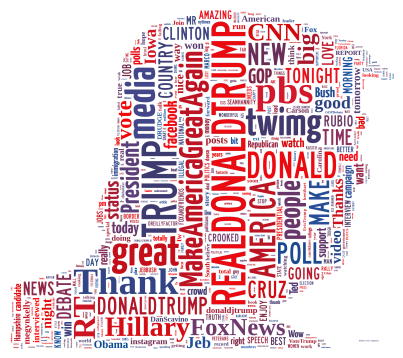Though polls now suggest Clinton has a wide lead over Trump in the upcoming election, many are still baffled that Trump got so far. So how can we explain Trump’s success in the race? Let’s start with his debate tactics.
During the GOP nomination, Trump used a series of debating strategies not normally used by traditional politicians. Donald Trump treats every debate as if it were an episode of The Apprentice, using language that appeals to the average Joe and that riles up crowds. His controversial campaign, though alarming, has made people tune in to the debates in record-breaking numbers.
So, what tactics does Trump employ on when speaking to debate viewers?
1. Simple sentences repeating memorable buzzwords
Donald Trump reverts back to one of his recognizable catchphrases in almost everything he says.
“Build the Wall!”
“Bring Jobs Back!”
“Make America Great Again!”
On the debate stage, Trump sounds unlike any traditional politician, filling his short, snappy sentences with his signature phrases. He repeatedly uses strong, punchy, one or two-syllable words, putting them at the end of sentences to emphasize his point. These phrases and buzzwords stuck in the public’s head and made him memorable, especially when he was competing amongst a sea of Republican candidates.
The problem is that although his simple language made him memorable in the crowded primary debates, it doesn’t hold up in long, one-on-one debates with Clinton, when his policy-void, incoherent phrasing often comes to light.
2. Creating stories out of his answers to complicated policy questions
When asked complex policy questions, Trump has a knack of turning his answers into easy-to-follow stories. His way of reducing policy questions to hero vs. villain descriptions capture the audience’s attention much more than long-winded, detailed policy proposals.
Take, for example, a part of Trump’s answer to a question about racial divides and policing in America:
“In Chicago, they’ve had thousands of shootings, thousands since January 1st. Thousands of shootings. And I’m saying, where is this? Is this a war-torn country? What are we doing? And we have to stop the violence. We have to bring back law and order. …
We have gangs roaming the street. And in many cases, they’re illegally here, illegal immigrants. And they have guns. And they shoot people. And we have to be very strong. And we have to be very vigilant.
In this way, Trump adds emotion to his answers and frame situations as good vs. evil, making people pay attention to what he’s saying and allowing him to get away with not backing up his answers with facts or detailed policy proposals.
3. Antagonizing opponents with personal attacks
Donald Trump is known for personal attacking all of his political opponents on a level never seen before in modern-day politics. During debates, Trump would use this tactic to draw attention to himself in a room full of candidates and distract viewers when he blanked on a policy question or when his own past was attacked.
Though Trump’s low-blows made him seem distasteful and juvenile, they usually also made the other candidate look worse over time. From Clinton’s e-mail scandals and Bill’s rumoured affairs, to Rubio’s low Senate attendance and the “Lyin’ Ted” image Trump created for Cruz, viewers started questioning the sincerity of Trump’s fellow candidates. The attacks also brought attention to Trump in the crowded primary debates, making him seem confident and assertive enough to be a leader.

Donald Trump’s most commonly used words on Twitter, Source: Pixabay
Donald Trump’s debating strategies worked brilliantly in the GOP primary debates, where he brought the most attention to himself amongst a sea of candidates. He attacked the integrity and leadership skills of his opponents until he was the only one left in the running. He shouted short, snappy one-liners to make viewers remember what he said, and spoke in a language that resonated with the audience. He always remained the star of the show.
His strategy, however, fared less well in a one-on-one debate format with Hillary Clinton, where his repetitive catchphrases and simple language were not enough to make him look like a credible candidate.
What do you think has been Trump’s most successful strategy in the debates?

Short, snappy catchphrases work well to invigorate a crowd. In Trump’s case too. I agree that he treated his opponents in the same way as the contestants on The Apprentice. Whether you love him or hate him, Trump is entertaining.
In his last debates with Clinton, his one-liners no longer worked. Strategic fail. Now the question is how much of a lead will separate Clinton from Trump when she wins?
LikeLike
I completely agree with you, Carole! The one-liners were not enough in Trump’s debates with Clinton, and she was prepared enough to target his weak spots instead.
As for how much of a lead Clinton will have, we’ll see in two weeks (but I think it’ll be “yuge”)!
LikeLike